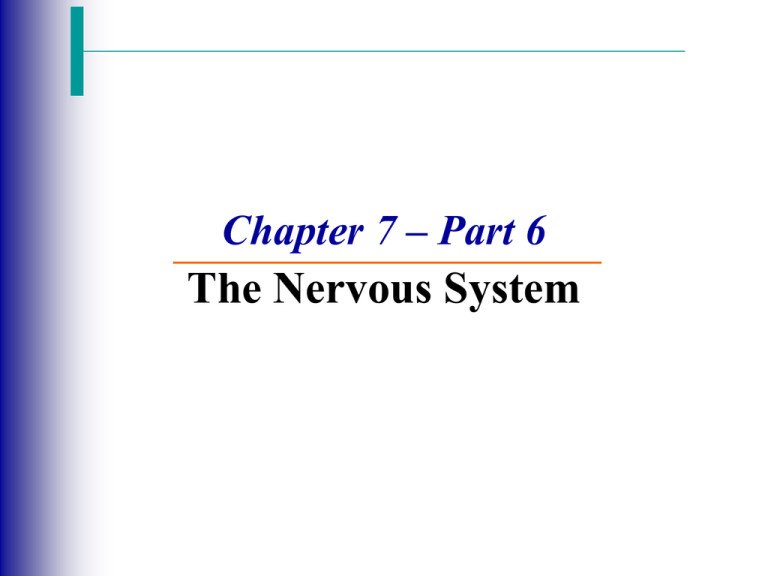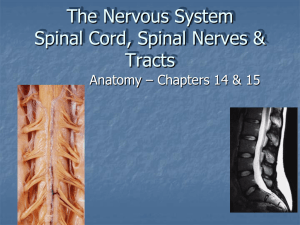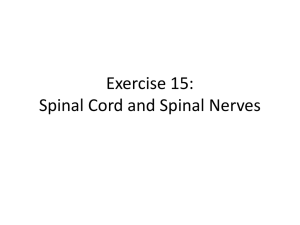Nervous System Part 6
advertisement

Chapter 7 – Part 6 The Nervous System Spinal Cord Extends from the medulla oblongata to the region of T12 Below T12 is the cauda equina (a collection of spinal nerves) Enlargements occur in the cervical and lumbar regions Where the nerves serving the upper and lower limbs arise and leave the cord Spinal Cord Provides a two-way conduction pathway to and from the brain. It is a major reflex center (the spinal reflexes are completed as this level) Cushioned and protected by meninges Spinal Cord There is no possibility of damaging the cord beyond L3 The meningeal sac inferior to that point provides a nearly ideal spot for removing CSF for testing. 31 pairs of spinal nerves Spinal Cord Anatomy Exterior White Matter Composed of myelinated conduction tracts Spinal Cord Anatomy Internal Gray Matter Composed mostly of cell bodies Looks like a butterfly or the letter H Spinal Cord Anatomy • Interior Gray Matter • Posterior (dorsal) horns – two posterior projections • Anterior (ventral) horns – two anterior projections Spinal Cord Anatomy • Central Canal • Contains cerebrospinal fluid • Surrounded by gray matter Spinal Cord Anatomy Nerves leave at the level of each vertebrae The dorsal and ventral roots fuse to form the spinal nerves Fuse to form the spinal nerves! Dorsal Root - The fibers of sensory neurons enter the cord here Ventral Root - The axons of motor neurons exit the spinal cord here Peripheral Nervous System Nerve - Bundle of neuron fibers found outside the CNS Neuron fibers are bundled by connective tissue Structure of a Nerve Endoneurium surrounds each fiber Groups of fibers are bound into fascicles by perineurium Fascicles are bound together by epineurium Cranial Nerves 12 pairs of nerves that mostly serve the head and neck Numbered in order, front to back Most are mixed nerves, but three are sensory only Spinal Nerves There is a pair of spinal nerves at the level of each vertebrae for a total of 31 pairs Spinal nerves are formed by the combination of the ventral and dorsal roots of the spinal cord Spinal nerves are named for the region from which they arise Spinal Nerves Anatomy of Spinal Nerves Spinal nerves divide soon after leaving the spinal cord (each spinal nerve is only about ½ inch long) Anatomy of Spinal Nerves The rami, contain both motor and sensory fibers. 1. Dorsal Rami – Serve the skin and muscles of the posterior trunk 2. Ventral Rami – Serve the limbs, the intercostal muscles, and the skin and muscles of the anterior and lateral trunk Autonomic Nervous System Autonomic Nervous System - The involuntary branch of the nervous system Consists of only motor nerves Divided into two divisions: 1. Sympathetic division 2. Parasympathetic division Autonomic Nervous System Body organs served by the autonomic nervous system receive fibers from both divisions. When both divisions serve the same organ, they cause antagonistic effects. Autonomic Functioning Sympathetic – “Fight-or-flight” Response to unusual stimulus Takes over to increase activities Increases heart rate, blood pressure, blood glucose levels, dilates the bronchioles of the lungs, and dilates the pupils Remember as the “E” division = Exercise, excitement, emergency, and embarrassment Autonomic Functioning Sympathetic – “Fight-or-flight” The effects of sympathetic nervous system activation continue for several minutes until its hormones are destroyed by the liver. Helps explain why we need time to “calm down” after an extremely stressful situation. Autonomic Functioning Parasympathetic – Housekeeping activites “Resting and digesting” system Chiefly concerned with promoting normal digestion and elimination of feces and urine and with conserving body energy Heart rate, blood pressure, and respiratory rates are at low normal levels; pupils are constricted; skin is warm; digestive tract is actively digesting food Remember as the “D” division - Digestion, defecation, and diuresis (urination)











